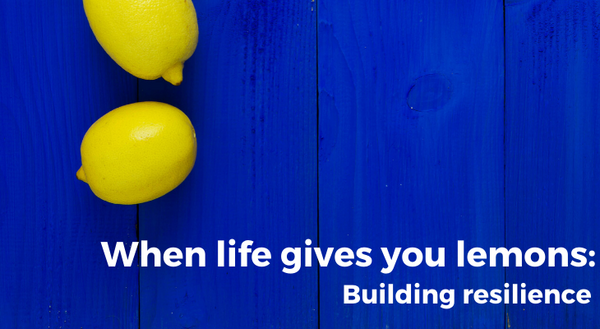
Surely, you’ve heard the saying, “when life gives you lemons, make lemonade.” When I think about all the lemons, we’ve been handed this year, it can be difficult to see how to make the lemonade – especially for children. If you have a child in your life, stop for a moment and consider all the challenges they have had to face since March. The transition to remote learning, lack of interaction with peers, and cancellation of activities, events, and celebrations have created prime ground for our kids – and ourselves – to develop our resilience.
According to the American Psychological Association, resilience is the “ability to adapt well to adversity, trauma, tragedy, threats or even significant sources of stress. It means ‘bouncing back’ from difficult experiences.” In helping to overcome adversity, resilience helps children (and adults!) learn to thrive in life, despite the circumstances. Exposure to the difficulties of life can even help one become strengthened or transformed by the difficulty. Resilience is a good thing and is how we make lemonade out of lemons.
Children of all ages and stages experience setbacks, challenges, adversities, and even failures. Sadly, children around the world are exposed to stressful, crisis situations including natural disasters, violence, and abuse and neglect. More often, children experience the less traumatic, but still impactful stressors of rejection from peers, parental or family problems, school or sport performance, or even exposure to world news. As best as parents and caregivers try, it is not always possible to keep children safe by preventing stress and trauma.
Resilience is not something people have or don’t have, nor is it something we are born with. It is a skill that can be learned and taught so that we are more able to cope with the uncertainties and problems in life.
The Center on the Developing Child at Harvard University identifies the presence of at least one supportive parent, caregiver, or other adult that provides stability and commitment as the single most common factor for building resilience in children. This means that not only parents, but teachers, coaches, grandparents, family members and others can plan a role in helping children overcome adversity. For children of all ages, there are several steps parents, caregivers, and others can take to build resilience in children:
- Accept and assist. Help your child understand that negative things will happen in their life. Talk through their feelings in relation to those events, thoughtfully suggesting ways for your child to emotionally cope with the setback. Focus on accepting your child for who she is – her strengths and weaknesses – and avoid criticism. Acceptance of your child teaches her that she will not be criticized, thus, helping her to become more confident, resilient, and appreciative of herself.
- Be realistic. Talk about realistic goals and expectations and encourage your child set achievable goals and expectations. In relation to goal setting, ask your child if he thinks the goal is realistic and brainstorm responses if the goal is not met. Help your child identify his strengths – and develop them.
- Listen and support. When children experience adversity, they often do not want to be lectured or given advice. Consider asking their opinion so they can practice communicating their feelings and perspective. Provide empathy and assurance that they will “bounce back” or even “bounce forward.” Let them know that you are listening and that you support them. Foster decision making and problem solving by asking your child his thoughts, feelings, and experiences with the set back. Let the child be the talker; you be the listener.
- Encourage participation. Resilience in children increases when they have a sense of belonging and empowerment. Encourage your child to become involved in his school and community as they are able. Assist them in seeking out positive friendships and activities where they feel they are contributing to the greater good. Teaching your child to handle disagreements and interpersonal difficulties effectively helps her address and handle difficult situations – and become more resilient.
- Provide challenge. To build resilience, it often means being exposed to a tough situation and living through it. While children should certainly be protected from dangerous or risky situations, small, appropriate doses of challenge can be offered every day to build resilience. Not all stress is harmful. Navigating manageable stress promotes growth and learning. Avoid eliminating all risk but allow appropriate risks to teach your child essential skills. Provide age-appropriate freedom and independence in activities to help your child learn his limits.
- Role model. Children learn through their parents and caregivers, often mimicking our attitudes and actions. How do you as a parent handle a setback or difficulty? What message is your handling of the situation sending your child? Overreacting or reacting negatively to life’s inconveniences teaches children that the trials of life are worth excessive attention and emotion. Strive to have a “we-can-get-through-this attitude” to better equip your child to face difficulties.
In reality, our children will at some time be faced with adversity – despite our best efforts. Whether it is the loss of a loved one, harsh words from a friend, poor grade on a school project, loss of the big game” or uncertainties about health and safety – challenges will come. Although uncertainty about returning to school, activities, and changes in routine are on the horizon, remember, it is through these difficult times that growth and character are developed – and lemons are made into lemonade.
To learn more about resilience, view University of Illinois Extension Family Life Educators, How High Do You Bounce: Building Resilience webinar.